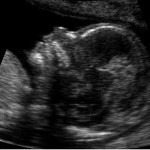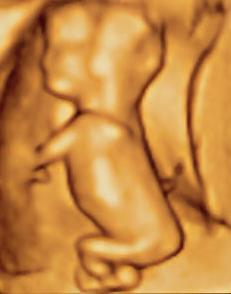Your Baby
Weeks 13 to 18
Your baby is about 6 1/2 inches long and weighs about 8 ounces. He has a strong heart beat and active muscles. His skin is covered with soft fine hair. His fingertips have fingerprints and fingernails and he can grasp with his hands. The bones start to harden and can be seen with an x-ray. All of his joints can move. By the end of this month you may feel your baby move, called quickening.
If you are eating a healthy diet, your blood will contain all the nutrients and calories your baby needs to build new tissues and have enough energy. If you don’t eat enough carbohydrates, your baby must get his energy by breaking down some of the new tissue he has just made. Starting about your 14th week, you’ll need an extra 300 calories each day to provide enough energy for your baby. Make every calorie count. Choose foods that have the most nutrients for the least amount of calories or meet more than one nutritional need such as lowfat milk (calcium, phosphorus, and vitamin D) or strawberries (vitamin C, iron, and fiber).
Physical Activity

Exercise and physical activity have a major effect on your pregnancy. Physical activity includes activity that involves the large muscles of your arms, back, buttocks, or legs such as climbing stairs and ladders, stooping, bending and exercise. Physical activity increases your need for calories. Your body supplies calories to you first, and then to your baby.
Mothers who have a lot of physical activity throughout pregnancy are at increased risk for preterm birth and often have babies with low birth weights. This is because physical activity reduces the blood flow to the uterus and sends extra blood to the muscles that are being used. The reduced blood supply to the uterus decreases the flow of oxygen and nutrients to your baby and waste products away from your baby. When the blood supply to the uterus is reduced, both the placenta and your baby don’t get enough oxygen and nutrients. Also, a lack of oxygen to the placenta can cause tissue in the placenta to die.
Ask your doctor which physical activities you should avoid. In general, avoid any physical activity that:
~ puts strain on your stomach muscles
~ increases your heart rate above 140 beats per minute
~ causes you to become too hot
~ increases your risk of falling
Physical activity affects your uterus in other ways. It can help to understand what happens as your uterus grows during pregnancy.
Growth of the Uterus
The outside of the uterus is covered with many blood vessels. The inside wall of the uterus is made of many small blood vessels. These blood vessels increase in size and number as pregnancy progresses. Also, the amount of blood in your body increases during pregnancy. This enormous blood supply carries oxygen and nutrients to the placenta for your growing baby and then carries your baby’s waste products away.
As your pregnancy progresses, your uterus grows upward, toward your rib cage, and outward, toward your hip bones. As it grows outward, the uterus presses against the bones of the pelvis and squeezes the blood vessels. The blood vessels are squeezed more and more as the uterus and your baby get bigger.
- The Uterus
- Before pregnancy, the uterus is located deep in the pelvis. It is about the size and shape of a pear and weighs 2 1/2 ounces and can hold about 1/3 ounce. During pregnancy it grows to about 3 1/2 pounds and can hold about 64 ounces. As the uterus grows, it expands up and out of the pelvis. Around 12 weeks, the uterus has expanded above the pubic bone and can be felt easily. Between 10 and 18 weeks, the uterus has expanded halfway to your bellybutton. By 20 to 22 weeks, the uterus has reached your belly button or even a little above it. By 28 weeks, the uterus has grown halfway to your breastbone. At 40 weeks, the uterus has reached your breastbone.
The uterus is a muscle. Like all muscles, it can contract and relax. When the uterus contracts, it feels hard when touched. When it relaxes if feels soft. The uterus contracts by itself, you can’t “make” it contract. But you can do things that “cause” it to contract. A contraction can feel like heartburn, a back ache, cramps, or pressure.
The Effects of Standing
Standing for long a long time increases the pressure on the blood vessles because the weight of the uterus and your baby is resting on your pelvis. As the blood vessels compress, it becomes hard for the blood from the lower part of your body to return to your heart. This congestion of blood in your lower body can cause your uterus to contract, allowing the blood to return to your heart.
If you keep standing once contractions begin, the contractions can become regular. Contractions that become regular can lead to preterm labor. As contractions become regular, the cervix begins to thin out and open. If the cervix opens enough, the bag of waters breaks and the mucous plug falls out making it harder to stop labor. Also, once the mucous plug falls out, your risk of infection is increased.
The Effects of Lifting and Carrying
When we lift, especially something heavy or awkward, we take a deep breath and tighten our stomach muscles, similar to “bearing down” during labor. Bearing down puts pressure on the uterus which can lead to contractions. How often and how much you lift is also important. Repeated lifting produces pressure more often than lifting once in a while. Lifting something heavy produces more pressure than lifting something light. Therefore, avoid lifting and carrying as often as possible.
Using proper body mechanics when you lift will reduce stress on your back and abdomen. When lifting, bend your knees instead of bending your back and reaching down. Hold the object close to your body, not out at arm’s length.
Limiting Your Physical Activity

Many mothers can stay physically active during pregnancy. However, studies show a link between physical activity and uterine contractions for mothers at risk for preterm birth. If you have risk factors for preterm birth, limiting your activity may be a must. If you limit your activity and get enough rest, you may be able to avoid being on bed rest. Keep in mind that pregnancy is only temporary. Try keeping a positive outlook. At times it can be hard to adapt emotionally and physically to limiting your activity. However, it’s very important to provide your baby with the best environment in which to grow and develop.
Your doctor may recommend limits on your physical activities or even suggest some bed rest. If you work outside the home, let your employer know about your limitations. If your doctor says it’s okay for you to continue working, ask your employer if reducing your workload is possible or if you can reduce the number of days you work each week.
If you begin having contractions, changes in your cervix, or other signs of preterm labor, your doctor may recommend that you stop working until after your baby is born. It’s helpful to find out about your health insurance benefits early in your pregnancy, especially if you know you are at risk for preterm birth.
Assessing your physical activity at home and work
Take a close look at all risk factors that affect you and make changes whenever you can. Until now, you may not have thought about how physical activity affects the health of you or your unborn baby. Check out your environment at home and work to find and reduce factors that can lead to preterm labor.
Include both mental and physical factors, such as standing, noise, lifting, carrying, and driving. How much do you stand during a typical day? Do you stand while washing dishes, doing laundry, making dinner, putting away laundry, or talking to friends and family? Do you have children to lift or carry? Do you have a long, tiring commute to work?
Your risks for preterm birth are increased if you work in a job:
~ where you stand for more than three hours a day
~ where you have continuous or “on and off” physical efforts
~ with a machine that vibrates or requires physical effort
~ where your work area is cold, wet, noisy, or you handle chemicals
Ways to reduce physical activity at work:
~ Rest as often as you can. Lie down when possible. Use your lunchtime and breaks to take care of yourself and to rest, not for running errands.
~ Prop up your feet when resting. Propping up your feet helps reduce swelling in your lower legs and reduces pressure on your cervix.
~ Don’t lift anything heavier than 15 pounds.
~ Don’t sit for longer than an hour at a time.
~ Stretch and change positions often.
~ Go straight home after work. When you get home, rest with your feet up for at least an hour before you begin making dinner or running errands.
Ways to reduce physical activity at home:
~ Ask friends or family to shop for you. If you must shop, make a list before you go and limit trips to 30 minutes.
~ Ask the store clerk to fill bags half-full so they are easier to carry.
~ Have items that must be taken into the house right away (milk, eggs, and frozen foods) put in the same bags and placed near the car door. If you must bring in the groceries, bring in only those that must be refrigerated or you need right away. Bring in the rest after you rest for 30 minutes to an hour.
~ Sit as much as possible while preparing meals, talking on the phone, or dressing children.
Self-care tips for preventing preterm labor
~ Avoid lifting heavy objects. If you have small children, have them sit beside you or in your lap instead of picking them up. Give them special attention by reading to them or sharing a quiet game.
~ Don’t get too tired. Rest at least 30 minutes between activities. Also, get as much sleep as you can. Rest improves the flow of blood to your baby.
~ Empty your bladder often. Keeping your bladder empty keeps pressure off your uterus. Pressure on an “irritable” uterus can turn into contractions.
~ Try to rest everyday at mid-morning, mid-afternoon, and mid-evening, lying on your left side. Lying on your left side keeps the blood circulating to your baby. [green]If you can rest only once a day—resting in the afternoon is best.[/green]